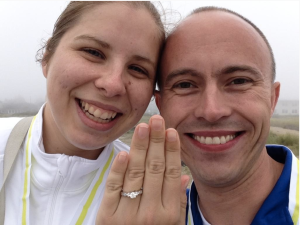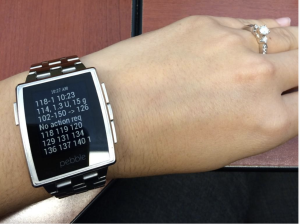So today I attended the 2012 Snohomish County Republican Convention. And yes, I think I really was the most moderate one there (of the people I met, anyway). And I ended up as the whip. Go figure.
It’s a long story. Maybe a couple people will read it all the way through, maybe not. 🙂
So a month ago, I decided to attend my precinct caucus to participate in deciding the Republican nominee for President. Since Washington’s caucuses were earlier this year, and the race is dragging on longer, this is the first time my presidential vote actually had a chance to count for something. And I have an opinion to express: Romney is a decent candidate (as was Huntsman), but the other three remaining ones are way too extreme to get my vote. I haven’t made up my mind who I’ll vote for in November, but I thought I’d do my part to make sure we had the best choices possible. So I made plans to show up on that Saturday morning for my local causes.
When I arrived, it was a pooled caucus at Everett High School, meaning all of the local precincts were together at different tables in the cafeteria. As it turns out, there were only three others from my caucus who showed up: Julie Lingerfelt, her husband, and their son. Our precinct had 2 delegates and 2 alternates to fill, so despite the fact that all three of them were Ron Paul supporters and I was for Romney, we didn’t even vote on it: Julie and I were unanimously elected delegates, and her husband and son the alternates, to the County convention today.
Lesson one: 50% of politics is just showing up.
Now, being slightly CDO myself (that’s like OCD, but alphabetized, like it should be) I wasn’t going to just show up at the caucus, sit back, and do nothing. No, I decided to read the proposed Snohomish County Republican Platform, and then further decided to revise it to something I could agree with. Remember, I’m a moderate here. So I did. Now, a plan was taking shape in my head that maybe I could do my own little part to help moderate the Snohomish County Republican Party a bit, and get them more to the point where they’d get more support from independents and moderates like me.
So, after I revised the platform, I then decided to send it to the GOP’s 38th Legislative District chair for feedback. I did get some good feedback, with advice on getting any amendments I wanted to propose to the County GOP office in advance. So, having caught the bug, I thought I’d drive down there and see what the process was. I talked to a couple ladies at the county GOP office, who had some additional info on the process, but more importantly, got me in touch with Bob Williams, the Platform Committee chair. Having learned by this point that there were going to be over a thousand delegates at the convention, I narrowed down my list to about a dozen amendments that I thought might actually get support, and sent those to him. Bob gave me some very good feedback, helping me eliminate some of them that didn’t really substantively change anything, and modify those that weren’t going to get consensus. The end result was a short list of four amendments, which I sent over as motions to be added to the agenda for the Platform discussion.
Now, having done all this (and exchanged a few more emails), Bob apparently recognized that I had a bit of passion or something (that’s my CDO, remember), and got my name over to Natalie Lavering, who was helping him coordinate the Romney campaign. Next thing I know, she’s asking me if I could be a floor leader for the Romney campaign for my 38th Legislative District. (The way it works is the County convention breaks into about 8 caucuses, one for each legislative district in the county.) She also invited me to a floor leaders’ meeting with the Romney campaign that evening. This stuff can move fast.
So, here I am, going to my first convention ever, and I’m supposed to be one of the floor leaders. Ok, that seems doable. Certainly there’ll be other people there who know what to do, right? We talked strategy and tactics at the floor leaders’ meeting that evening, which basically boiled down to this: The Romney campaign was, at the time, cooperating with both the Santorum and Gingrich campaigns to put forward a Unity slate of candidates, which would give proportional representation to Romney, Santorum, and Gingrich delegates according to the number of delegates each one had won at the precinct caucuses. (The way the voting works at these conventions is you have to have a majority (50%+) to get anyone elected a delegate in the first three rounds of voting, after which it drops to a plurality vote. So if you can get more than half of the caucus to agree on which of the 23 delegates they’re going to vote for, your slate wins.)
Now, as it turns out, the 38th LD that I live in is one of the less traditionally Republican in Snohomish county (representing urban Everett etc.), so it turns out that the Ron Paul folks had a plurality of the declared delegates in our LD, unlike in any other district in the county. Romney was behind by only a couple delegates, and neither had a majority, but if you added up the Paul and Santorum delegations, along with their undecideds, they did. And as we were wrapping up the meeting, there were already rumors that the Santorum national leadership was coming in to override the deal the local Santorum leadership had made with the Romney and Gingrich campaigns. I still don’t know all the details, but suffice it to say that’s exactly what happened, and it sounds like it got ugly within the Santorum camp for a bit. At least in our LD, there were some local leadership who wanted to stick with their party, and stayed on the Unity slate, and others who sided with the national leadership to do some sort of alliance with the Ron Paul folks (in the interest of denying Romney a majority and pushing for a brokered convention).
But, I didn’t know all the details of that yet when I showed up early on a Saturday morning for the caucus. All I knew was that I was supposed to get myself signed in, and report to the Romney table, where I’d get some stickers, a floor leaders’ cap, and this Unity slate they kept talking about.
So that’s what I did. But Kurt, our poor LD chair, was getting overwhelmed checking in all 178 delegates, plus alternates, so I offered to come back and help him after I got checked in. Even with additional help, that took until after 9am when the convention and speeches started, and meant that I got a late start on collecting the 5 signatures I was supposed to get for each of my 4 platform amendments and turn in to the Secretary by 9:30. But, I went ahead and got them signed, and caught her once she finally stepped down from the dais for a minute to hand them over.
So, I was finally back on track. And now we just had to wait for the folks checking everyone’s credentials to finish their work and come give their report, which meant more speeches. McKenna’s was pretty good: I agree with a lot of what he has to say. But a lot of the others were typical red meat conservative stuff, which I found myself laughing at more than applauding to. Anyway, I finally got myself seated with my LD before the speeches finished. Once they did, and the Credentials Committee gave their report, we finally got down to the first order of business: selecting the permanent Chair for the rest of the convention. I knew it was important that we make sure we didn’t have someone with the goal of delaying the convention, so I figured this was important, and made sure I knew whom to vote for. It turns out, though, that this was the part of the main convention that delayed us the most, because the initial voice vote was declared before it was unambiguous, so we had to go to a show of hands. But then the three people who counted the hands couldn’t agree on the count, with counts ranging from 590 to over 800, with 622 required for a majority. So then we had to all stand up and count ourselves off as we sat down. Someone obviously didn’t know how to count, because we got to 640 and stopped while there were obviously still over a hundred people standing. Anyway, with that finally out of the way, we got do the discussion of the rules. There were a couple motions, both defeated, regarding nominations and candidate speeches. And then, FINALLY, we got to adjourn to our LD caucuses, and more importantly, get lunch. (I think it was well after 1pm at this point).
Over lunch, the Romney campaign finally distributed the Unity slates. There was a Delegate slate and an Alternate slate, and I had no idea who was who on it (except that I had made the cut for the delegate slate, woohoo!). After a few minutes to get (but not finish eating) our lunch, we got started on the real business, the 38th Legislative District Caucus. We had another contested vote for the chair of the LD caucus, but went straight to stand-up-and-count-off, and got through it pretty quickly. Kurt got elected as permanent Chair, but with only a plurality (there were probably some people still doing lunch or something). So we finally had ourselves a caucus and could get down to the business of nominating delegates, letting them give their 30s speeches, and voting on them.
Now back when we got our call to the convention, there was a paper included where any interested delegate or alternate could get their name added to the pre-printed ballot for delegates to the State convention. I had done so, but once I started really looking through our Unity slate, it turns out there were a lot of names on the slate of people who hadn’t. That was a bit concerning, but I knew we got to do floor nominations, so we got down to the business of nominating everyone on our Delegate slate from the floor. As we did so, we discovered that there were four of our 23 who had refused nomination, or for some other reason didn’t end up as candidates. So, we had to figure out who to vote for, in addition to our remaining 19 (who, remember, were Gingrich and even a couple Santorum delegates in addition to Romney). So we all gave and listened to everyone’s 30s speeches, and tried to figure that out for ourselves.
And then, finally, we got to the first ballot. All the declared Romney supporters knew they were supposed to vote the slate, and I think most of them did, but we didn’t have the numbers to get anyone through on the first ballot, and in fact the non-Unity camp managed to get 4 (turns out they were all for Santorum). So, after this, I finally realized that we needed to be coordinating better. I had thought someone else would be coordinating things, but apparently not. So, having seen the Paul camp run off to the back of the room to huddle, I called over all the Unity supporters to the side of the room and attempted to get everyone on the same page.
I don’t remember what all was said, but I think we managed it, because on the 2nd ballot only one more (Santorum) go through, and no one advanced on the 3rd ballot. Turns out I was worried about the wrong thing, though, because I thought we’d lose more than that on each ballot (remember the numbers were against us), so I was trying to figure out who we’d eliminate (as a group) if we didn’t have enough slots. But it turns out the 3rd ballot was important for another reason: they eliminated everyone except the top 36 candidates (to fill the 18 remaining slots), which meant if we hadn’t been coordinated, we wouldn’t have had enough of our folks to vote for on the 4th and final ballot. The 4th ballot runs by different rules: it only requires a plurality, and the remaining slots are filled by the top vote-getters all the way down. We voted our slate and ended up with 6 of the 18 remaining slots. The ones of ours who won were the long-time well-known Republicans on our slate: no big surprise there. Newbies like me didn’t make it through, and given the numbers we had, I wasn’t really expecting to be elected a delegate. Turns out there were about 11 Paul supporters elected delegates, the 5 Santorum ones, the 6 from our slate, and maybe one more Gingrich delegate.
I was still hoping to be an alternate in Tacoma, and knew at least some alternates would be seated as delegates there, so we reconvened yet another Unity caucus meeting and decided as a group who we’d nominate and vote for as alternates if they didn’t win as delegates. (Because of the timing, the only time we had to caucus and strategize was actually after each vote, but *before* the results came back from the vote-counters. So each time we were planning our next move without knowing the results of the last one.) Our delegates did a pretty good job coordinating, but unfortunately it was getting late, and I think we were losing people. (The Paul camp is more organized, and better at sticking things out.) In any event, we only managed to get one alternate elected in the first round and two in the second round. And none of them were very highly ranked, which means they’re less likely to get promoted to delegates in Tacoma. And no, I wasn’t one of the three.
Now, by this time, it was after 8pm, and there were some LDs that were moving a lot more slowly than we did. So it was clear we weren’t going to get to the platform after all, and that they’d have to reconvene us all at a later date and try to get a 40% quorum. Which means I haven’t (yet?) had a chance to present or discuss my 4 platform amendments, which was one of my main goals in being there. But as often happens, life is much more interesting when it doesn’t go as you had planned. Our caucus was a lot of work, but a lot of fun, too.
So, that’s how I, the most moderate person (I know of) from the least conservative legislative district in the county, ended up as the whip for the Romney campaign at our LD caucus. (And if you’re not familiar enough with political jargon to understand why that’s ironic, the whip, in a legislative body, is the legislator who rounds up the votes for their party. They’re usually one of the most partisan legislators that party has.)
So: Lesson two: apparently the other 50% of politics is just speaking up.


